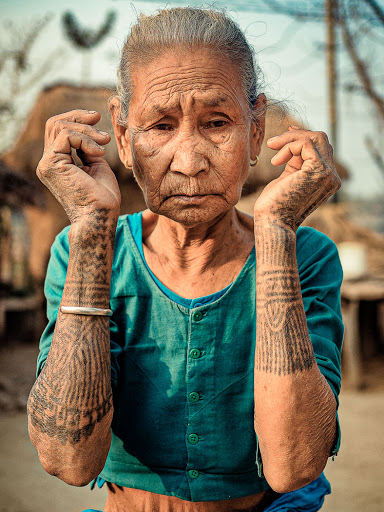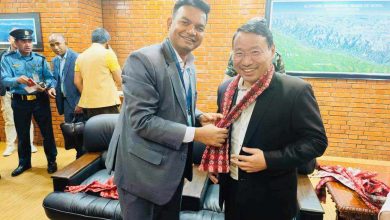As young girls shy away from tattooing tradition, Tharu grannies are skeptical about its continuity

Bhulung Chaudhary, 98, inked an indigenous tattoo on the back of her hand when she was around 12. Sharp needle dipped in handmade color inked her first childhood tattoo.
It pained her a lot. Her hands swelled. These drawbacks didn’t deter her to ink more in upcoming years until she turned 25. She tattooed on her foot, ankle, thigh, abdomen, forearm, arm, wrist, neck, shoulder and almost everywhere possible.
”Tattoo artists would come from India to put tattoos on our body parts for Indian Rupees”, said Bhulung, who was born in Itahari-14 Narbhasa and married to Itahari-7, Bajraha in her adolescent age. She added, ”I paid 2 Indian Rupees to ink every new tattoo.”
It was a common cultural practice to tattoo for girls between the ages of 12 to 25 in the Tharu village, said Bhulung blending both Nepali and Tharu languages. Chaudhary, second of the three sisters in the family, said all her siblings tattooed various geometrical and natural symbols they loved.
After 86 years, once the widespread tattooing tradition in Tharu communities is shrinking. Young generations and millennials are no more interested in this traditional tattooing to the annoyance of nonagenarian Bhulung Chaudhary.
”I have three daughters. Only eldest and second daughter tattooed” said Bhulung in her feeble voice caused by asthma. She added, ”My youngest daughters and all young ladies are not doing what we used to do.”
Similar is the story of Munni Chaudhary, 45. Born to a peasant family in Chhitaduhabi of Gadhi Rural Municipality of Sunsari, Munni tattooed at the age of 15 in her own village by paying Rs 40. ”People from western Nepal would come to our village from Mangshir (Mid-November) to Falgun (Mid-February),” said Munni. ”I have one daughter and two daughters-in-law. But, they don’t ink tattoos like ours.”
Chinti Chaudhary, 70, was born and bred at Itahari-7, Bahraja. She tattooed her legs and hands together with her contemporary friends back then when she was in early teens. Her two daughters and three daughters-in-law, though, don’t have traditional tattoos like her. ”Nowadays, our girls don’t like tattoos. Tattoo-making people also stopped coming to our village,” said Chinti. Chinti said that not a single traditional tattoo is found in ladies below 40-year-olds in her village.
Tharu’s tattoos: From cultural symbols to lifelong ornaments of women
Tharu’s native name of their traditional tattoo is called ‘Godna’. Some even call it ‘Khodna’. In the native Tharu language, the process of tattooing is called ‘Leela’. Tattooing is regarded as a lifelong ornament to women, mostly married. ‘Gudni’ is the native term to describe professional traditional tattooer in Tharu language.
According to informed Tharu elders, tattooing is donned for ladies with the age bracket of 12 to 25 years. It is performed by some specific traditional tattoo artists from India. Tharu grannies said there is a particular caste from west Nepal called ‘Tikharni’ which put tattoos on Tharu. The peak season of tattooing is the marriage months of the communities.
According to Ram Dhami, a cultural expert on the Tharu community, tattooing on a section of legs was considered a must-do thing prior to the marriage ceremony in the Tharu communities. Dhami, also the former Member of Academic Assembly at The Nepal Academy of Music and Drama, heavily tattooed women were mostly married in the past.
Satan Chaudhary, 64, a cultural activist of Itahari said tattooing was also a collective community drive to prevent the forceful marriage of Tharu woman by ruling elites of ancient Nepal. ”It is said by some of the elders of our Tharu community that ruling elites would consider tattooed women as married ones. Therefore, they would not be forcing them to marry,” explained Satan.
‘Tetanus fears fading indigenous tattoos’
Pustika Chaudhary, 18, is a young Tharu girl from Itahari having an interest in cultural activities. However, she is in no mood to ink cultural tattoos like her ancestors. She said she feared possible medical complications after painful inking.
Tharu elders of Itahari are sad on soon-to-be vanishing indigenous art of the community. Satan Chaudhary said young generations must be conscious to prolong this threatened tradition. ”Young and educated members of our communities must follow this age-old tradition,” suggested Satan.
He said susceptibility to transmit tetanus is being wrongly spread among the young generation and to their parents to escape this tattoo tradition. ”People are saying tetanus is spread from our traditional tattoos,” Satan claimed. ”This is false. Should it spread like rumors, all our mothers wouldn’t have lived longer.”









प्रतिक्रिया राख्नुहोस्